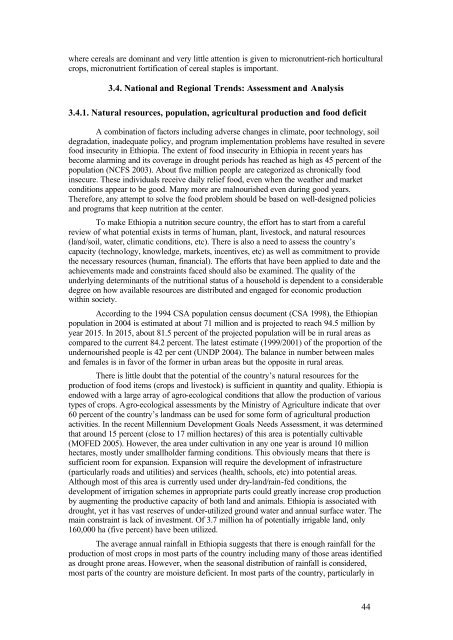An assessment of the causes of malnutrition in Ethiopia: A ...
An assessment of the causes of malnutrition in Ethiopia: A ...
An assessment of the causes of malnutrition in Ethiopia: A ...
You also want an ePaper? Increase the reach of your titles
YUMPU automatically turns print PDFs into web optimized ePapers that Google loves.
where cereals are dom<strong>in</strong>ant and very little attention is given to micronutrient-rich horticultural<br />
crops, micronutrient fortification <strong>of</strong> cereal staples is important.<br />
3.4. National and Regional Trends: Assessment and <strong>An</strong>alysis<br />
3.4.1. Natural resources, population, agricultural production and food deficit<br />
A comb<strong>in</strong>ation <strong>of</strong> factors <strong>in</strong>clud<strong>in</strong>g adverse changes <strong>in</strong> climate, poor technology, soil<br />
degradation, <strong>in</strong>adequate policy, and program implementation problems have resulted <strong>in</strong> severe<br />
food <strong>in</strong>security <strong>in</strong> <strong>Ethiopia</strong>. The extent <strong>of</strong> food <strong>in</strong>security <strong>in</strong> <strong>Ethiopia</strong> <strong>in</strong> recent years has<br />
become alarm<strong>in</strong>g and its coverage <strong>in</strong> drought periods has reached as high as 45 percent <strong>of</strong> <strong>the</strong><br />
population (NCFS 2003). About five million people are categorized as chronically food<br />
<strong>in</strong>secure. These <strong>in</strong>dividuals receive daily relief food, even when <strong>the</strong> wea<strong>the</strong>r and market<br />
conditions appear to be good. Many more are malnourished even dur<strong>in</strong>g good years.<br />
Therefore, any attempt to solve <strong>the</strong> food problem should be based on well-designed policies<br />
and programs that keep nutrition at <strong>the</strong> center.<br />
To make <strong>Ethiopia</strong> a nutrition secure country, <strong>the</strong> effort has to start from a careful<br />
review <strong>of</strong> what potential exists <strong>in</strong> terms <strong>of</strong> human, plant, livestock, and natural resources<br />
(land/soil, water, climatic conditions, etc). There is also a need to assess <strong>the</strong> country’s<br />
capacity (technology, knowledge, markets, <strong>in</strong>centives, etc) as well as commitment to provide<br />
<strong>the</strong> necessary resources (human, f<strong>in</strong>ancial). The efforts that have been applied to date and <strong>the</strong><br />
achievements made and constra<strong>in</strong>ts faced should also be exam<strong>in</strong>ed. The quality <strong>of</strong> <strong>the</strong><br />
underly<strong>in</strong>g determ<strong>in</strong>ants <strong>of</strong> <strong>the</strong> nutritional status <strong>of</strong> a household is dependent to a considerable<br />
degree on how available resources are distributed and engaged for economic production<br />
with<strong>in</strong> society.<br />
Accord<strong>in</strong>g to <strong>the</strong> 1994 CSA population census document (CSA 1998), <strong>the</strong> <strong>Ethiopia</strong>n<br />
population <strong>in</strong> 2004 is estimated at about 71 million and is projected to reach 94.5 million by<br />
year 2015. In 2015, about 81.5 percent <strong>of</strong> <strong>the</strong> projected population will be <strong>in</strong> rural areas as<br />
compared to <strong>the</strong> current 84.2 percent. The latest estimate (1999/2001) <strong>of</strong> <strong>the</strong> proportion <strong>of</strong> <strong>the</strong><br />
undernourished people is 42 per cent (UNDP 2004). The balance <strong>in</strong> number between males<br />
and females is <strong>in</strong> favor <strong>of</strong> <strong>the</strong> former <strong>in</strong> urban areas but <strong>the</strong> opposite <strong>in</strong> rural areas.<br />
There is little doubt that <strong>the</strong> potential <strong>of</strong> <strong>the</strong> country’s natural resources for <strong>the</strong><br />
production <strong>of</strong> food items (crops and livestock) is sufficient <strong>in</strong> quantity and quality. <strong>Ethiopia</strong> is<br />
endowed with a large array <strong>of</strong> agro-ecological conditions that allow <strong>the</strong> production <strong>of</strong> various<br />
types <strong>of</strong> crops. Agro-ecological <strong>assessment</strong>s by <strong>the</strong> M<strong>in</strong>istry <strong>of</strong> Agriculture <strong>in</strong>dicate that over<br />
60 percent <strong>of</strong> <strong>the</strong> country’s landmass can be used for some form <strong>of</strong> agricultural production<br />
activities. In <strong>the</strong> recent Millennium Development Goals Needs Assessment, it was determ<strong>in</strong>ed<br />
that around 15 percent (close to 17 million hectares) <strong>of</strong> this area is potentially cultivable<br />
(MOFED 2005). However, <strong>the</strong> area under cultivation <strong>in</strong> any one year is around 10 million<br />
hectares, mostly under smallholder farm<strong>in</strong>g conditions. This obviously means that <strong>the</strong>re is<br />
sufficient room for expansion. Expansion will require <strong>the</strong> development <strong>of</strong> <strong>in</strong>frastructure<br />
(particularly roads and utilities) and services (health, schools, etc) <strong>in</strong>to potential areas.<br />
Although most <strong>of</strong> this area is currently used under dry-land/ra<strong>in</strong>-fed conditions, <strong>the</strong><br />
development <strong>of</strong> irrigation schemes <strong>in</strong> appropriate parts could greatly <strong>in</strong>crease crop production<br />
by augment<strong>in</strong>g <strong>the</strong> productive capacity <strong>of</strong> both land and animals. <strong>Ethiopia</strong> is associated with<br />
drought, yet it has vast reserves <strong>of</strong> under-utilized ground water and annual surface water. The<br />
ma<strong>in</strong> constra<strong>in</strong>t is lack <strong>of</strong> <strong>in</strong>vestment. Of 3.7 million ha <strong>of</strong> potentially irrigable land, only<br />
160,000 ha (five percent) have been utilized.<br />
The average annual ra<strong>in</strong>fall <strong>in</strong> <strong>Ethiopia</strong> suggests that <strong>the</strong>re is enough ra<strong>in</strong>fall for <strong>the</strong><br />
production <strong>of</strong> most crops <strong>in</strong> most parts <strong>of</strong> <strong>the</strong> country <strong>in</strong>clud<strong>in</strong>g many <strong>of</strong> those areas identified<br />
as drought prone areas. However, when <strong>the</strong> seasonal distribution <strong>of</strong> ra<strong>in</strong>fall is considered,<br />
most parts <strong>of</strong> <strong>the</strong> country are moisture deficient. In most parts <strong>of</strong> <strong>the</strong> country, particularly <strong>in</strong><br />
44
















